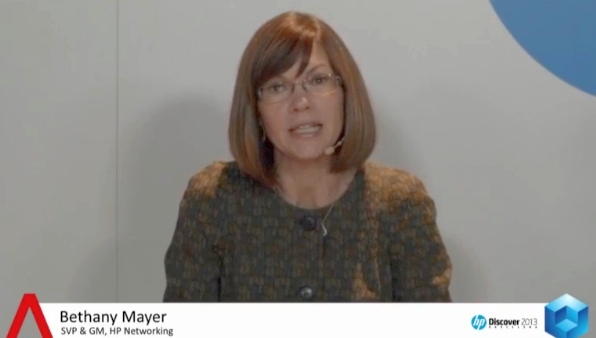 NEWS
NEWS
 NEWS
NEWS
 NEWS
NEWS
![]() Stationed in Barcelona for the HP Discover event, John Furrier and Dave Vellante, theCUBE co-hosts, joined forces to interview Bethany Mayer, SVP and GM with HP Networking, talking about OpenFlow and SDN.
Stationed in Barcelona for the HP Discover event, John Furrier and Dave Vellante, theCUBE co-hosts, joined forces to interview Bethany Mayer, SVP and GM with HP Networking, talking about OpenFlow and SDN.
“SDN is exploding and it’s getting bigger by the minute. We have now 25 million ports, 40 of our platforms are OpenFlow enabled, on the switching side 10 routers are now OpenFlow enabled, we just GA’s our SDN controller and we also announced our SDK in the first quarter of the coming year, as well as our app store,” said Mayer.
“There’s a tremendous interest in these products and we have a very interesting partnership with VMware around NSX,” she goes on. “The reality is the network needs to be more responsive to new applications; everything is about the application, not the network, and so the network needs to change to support those applications.”
“What’s going on under the hood for dev-ops, in the cloud, relative to the SDN?” asked Furrier.
“The Tier 1s of the service providers like the Facebooks and the Googles of the world were the first ones to embrace SDN (software defined network). Instead of having a bunch of guys typing CLIs into a bunch of switches and modifying the network at a very slow pace using a lot of resources, they threw that whole model out of the window and decided to program the network in an automated way using software, making sure the network was responsive to the apps running over it for the customers. They completely changed the paradigm within their own environment,” stated Mayer.
“Enterprises are beginning to see now that the concept of software-defined network, where you could have the network to be automated and dynamic, is also important in the enterprise,” Mayer noted. “As the result of the Enterprise going to the cloud, becoming more mobile, as the result of Big Data being hosted in the enterprise, being utilized by it, all of those things will require more automation and a more dynamic nature.”
“We are not advising people to throw everything away. In the enterprise you have a more heterogeneous environment: you have legacy network, applications built maybe 20, 30 years ago, still required by the business, and the idea is that you can utilize SDN in certain segments of your business or your network and retain the network infrastructure that you have in place, while also making it better. Over time you can migrate to an SDN based network. We have migration tools to do that, a V switch to create a virtual network across your network and utilize SDN that way, there’s a lot of different options on how to get from where you are now to a fully SDN enabled network, and we have all the tools and the knowledge to help you get there.”
Talking about the strategy for developers, Mayer admitted that “the Nirvana they aim for is making sure that the network can be programmable and automated and remain efficient for the Enterprise. From our perspective, it’s great value being able to go all the way up to the VM, being able to manage and control VMs, have visibility to them and decide how you want to do that, and there’s also great value being able to control the network infrastructure devices set beneath them. What we’ve done with VMware, we’ve federated the controllers so you’ll get both: full, rich management capabilities associated with VMs and full programmability and automation for the network devices that sit beneath those.”
Mayer is not scared of competition and she has a pretty good idea of who’s going to win the race: “Customers like open standards and heterogeneity, they like choice, they also like dynamic behavior of network,” she said, bashing Cisco for building boxes that are not even compatible with their previous models.
“The idea behind our developer environment and ecosystem is to partner with all of the application providers in the world that we live in, like SAP, Microsoft, Infoblox, VMware, that really want the network to respond appropriately. They are using our APIs and they are writing applications for the network so that when you launch a link session, that link works out beautifully between two users. As for the customers, when they get their SDN controller, in the management panel there’s a little button that they can push to get into the app store, and download that application capability into their network.
THANK YOU